Artists
Janaina Tschäpe Captures ‘Fragments of Memory’ in Lyrical New Works
The artist's new exhibition "a sky filled with clouds and the smell of blood oranges" is now on view at Sean Kelly in New York.
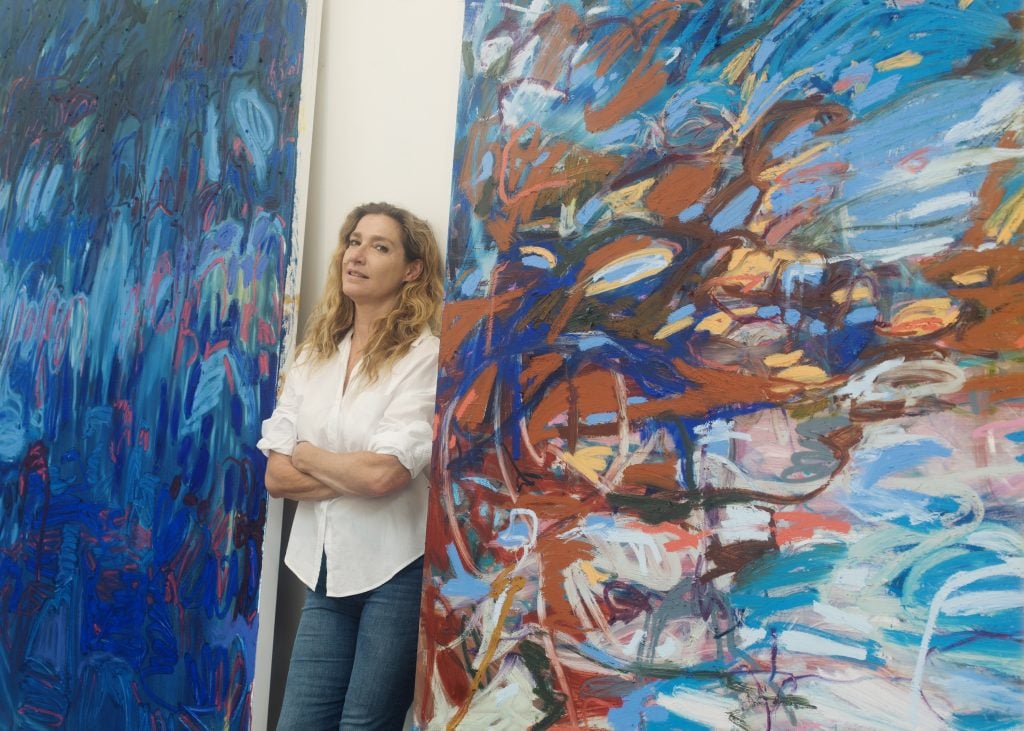
In her Brooklyn studio, German-Brazilian artist Janaina Tschäpe works in crescendos and pauses, building her lyrical abstract paintings that are redolent of memories, landscapes, remembered sounds, and evocative scents.
Just a few weeks ago, the artist put the final touches on a new group of paintings for “a sky filled with clouds and the smell of blood oranges” her fourth solo exhibition with Sean Kelly, now on view in New York (through October 19). In these new canvases, Tschäpe taps into her deepest artistic instincts, working from feeling and intuition to create pieces that range from intimate works on paper to symphonic multi-paneled paintings. Together these paintings create a poetic sense of call-and-response.
These works speak to Tschäpe’s rich internal world and her multifaceted passions, including the poetry of Mexican writer Octavio Paz, German philosophy and landscape painting, and the propulsive paintings of Swedish playwright August Strindberg. In her oil and oil stick canvases and smaller pastels and watercolors, these heady fascinations coalesce with sensory delights of the artist’s surroundings at the moment, the rain outside a window or an afternoon spent in the sun, creating tension between the immediate and the remembered, what’s known and what’s felt.
The exhibition at Sean Kelly also coincides with an extensive new monograph on the artist’s work, including an essay by art historian Joachim Pissarro, published by Hatje Cantz and Sean Kelly. “Tschäpe’s canvases serve as arenas wherein the visible intermingles with the visceral, inviting us to traverse conceptual depths through layers of paint and memory that subtly insinuate rather than explicitly reveal,” Pisarro writes in his essay.
Recently, we spoke to the artist at her studio in Bed-Stuy to discuss her newest works and recent rediscovery of pastels.
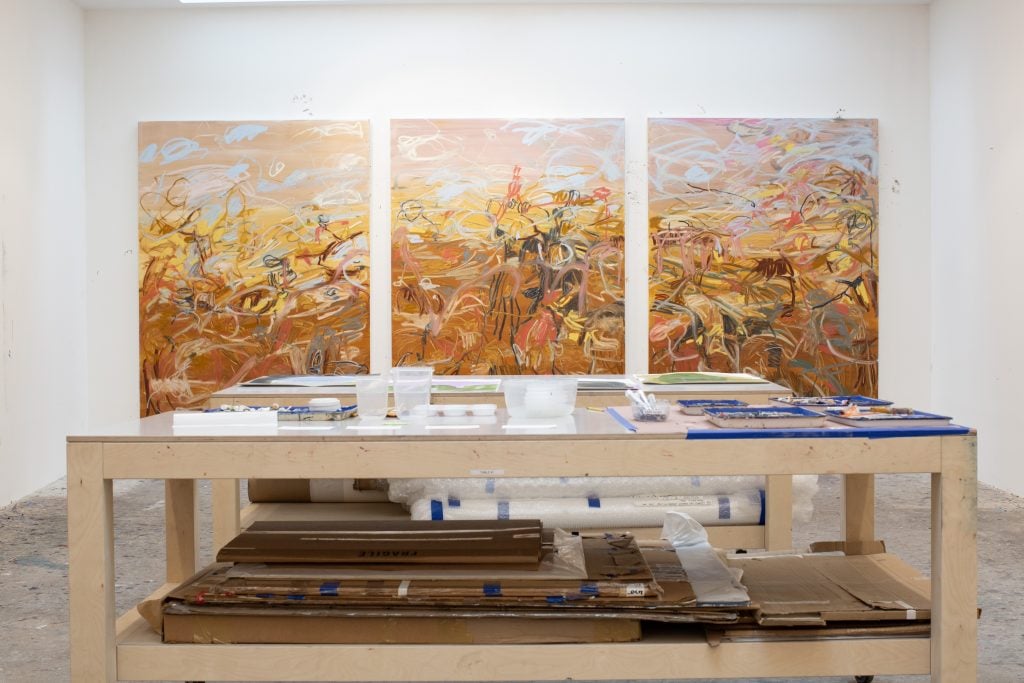
Inside Janaina Tschäpe’s Bed-Stuy studio, 2024. Courtesy of Janaina Tschäpe Studio.
Tell us about your studio.
My current studio is located in Bed-Stuy, Brooklyn. The neighborhood has seen significant changes over the years, much like the studio itself. It used to be a car garage. I initially made simple renovations: added some drywall and installed skylights. At that time, I was living in Williamsburg with my daughter, Mina, who was 3 1/2 years old, so it was crucial for me to maintain a separation between home and have fixed working hours.
In 2019, I undertook a major renovation, adding two stories to incorporate my living space into the studio. This integration of home and studio has given me the freedom to work at any time, whether late at night, or on weekends. I no longer have to confine myself to a strict schedule; I can immerse myself in my work whenever the painting demands more time. I particularly enjoy working on weekends when the studio is silent, allowing me to play loud music and immerse myself in the creative process without any distractions. The merging of my home and studio has been a significant change, offering a new level of flexibility and creative freedom.
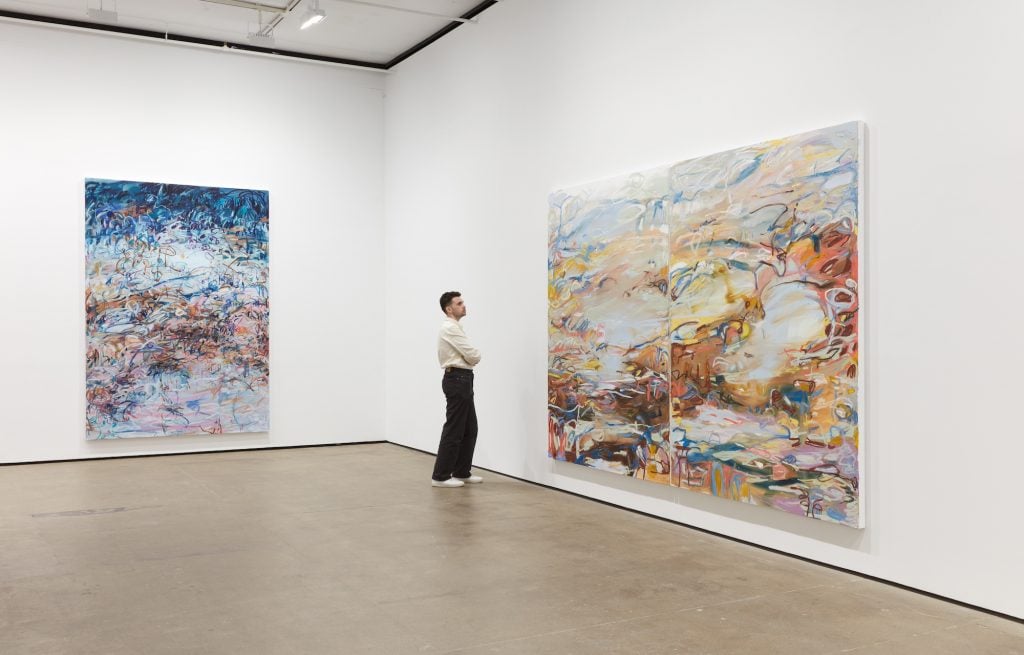
Installation view of “Janaina Tschäpe: a sky filled with clouds and the smell of blood oranges” at Sean Kelly, New York. Photography: Jason Wyche, Courtesy: Sean Kelly, New York/Los Angeles
What was it like working toward your exhibition “a sky filled with clouds and the smell of blood oranges” now on view at Sean Kelly? How does the title relate to these works specifically?
When working toward this exhibition, I didn’t follow a specific approach. My process was continuous—it wasn’t about creating work for this specific show but rather a constant flow of creativity. This contrasts with the exhibition I had at Sean Kelly in 2021, where I purposely made large, monumental works specifically designed to fit in the space in a precise way.
Last November, I started a painting that became the first piece of this exhibition, a large triptych titled Walking through fields (Passeando no tempo) (2023). This piece set the tone for the rest of the show, sparking a place for the other works to follow. The triptych is a work comprised of three individual canvases each talking to each other to create one cohesive work. I knew then I wanted to create an exhibition, where all the works spoke to each other in the context of the exhibition, creating a visual dialogue. I decided to trust my gut and to make an array of works of varying sizes and materials, allowing myself to move fluidly between them, creating connections between them, creating a language space that I carved out, a cohesive visual language.
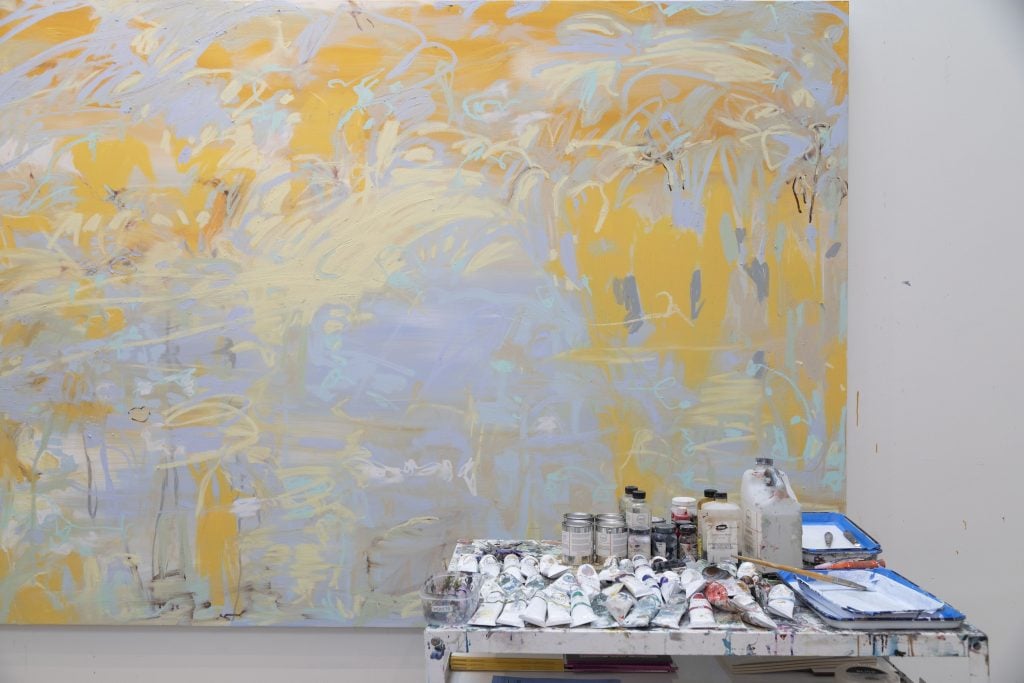
Inside Janaina Tschäpe’s Bed-Stuy studio, 2024. Courtesy of Janaina Tschäpe Studio.
I just completed the last painting for the show a few weeks ago. The process was interesting because, even though I had felt I had done enough work, when I looked at them all, selected what I thought worked as a group, and I had an idea of what the installation would look like in the gallery, the works did not have the visual clarity I wanted. I knew I needed one more work. With the completion of wonderland (2024), I knew I now had all the elements I needed to make this visual poem I had envisioned. Now, with all the works determined, I could title exhibition. These works came from memories, fragments of observations of nature—like looking at the sky and remembering things, feeling the smell of things.
The exhibition press release mentions intimacy and the “emotional and poetic potential of art.” How does your internal landscape inform these works?
My paintings are inner landscapes, which are observed, forgotten, brought to light again, filtered through dreams and distant recollections, composed of fragments, reduced to a few elements or supplemented by others, but always abstracted into lines, brush strokes, or surfaces. The painting space is for me a real space, a space linked to the moment and which I only invent in the moment of painting.
My painting is more visceral than literal. I feel deeply connected to the environment around me; there’s always a relationship to the location and the events happening there, like the smell of rain, the changing weather, or the colors in the sky. These experiences leave traces and fragments in my memory that I express through the painting. This connection with my surroundings drives the gestural and poetic elements of my work.
I explore different light conditions simultaneously: light between shadows, in a narrow passage, in a vast, open landscape, or in a landscape hemmed in by trees and rocky outcrops, perhaps even in the dark, different levels and layers interact and change continually, everything changes.
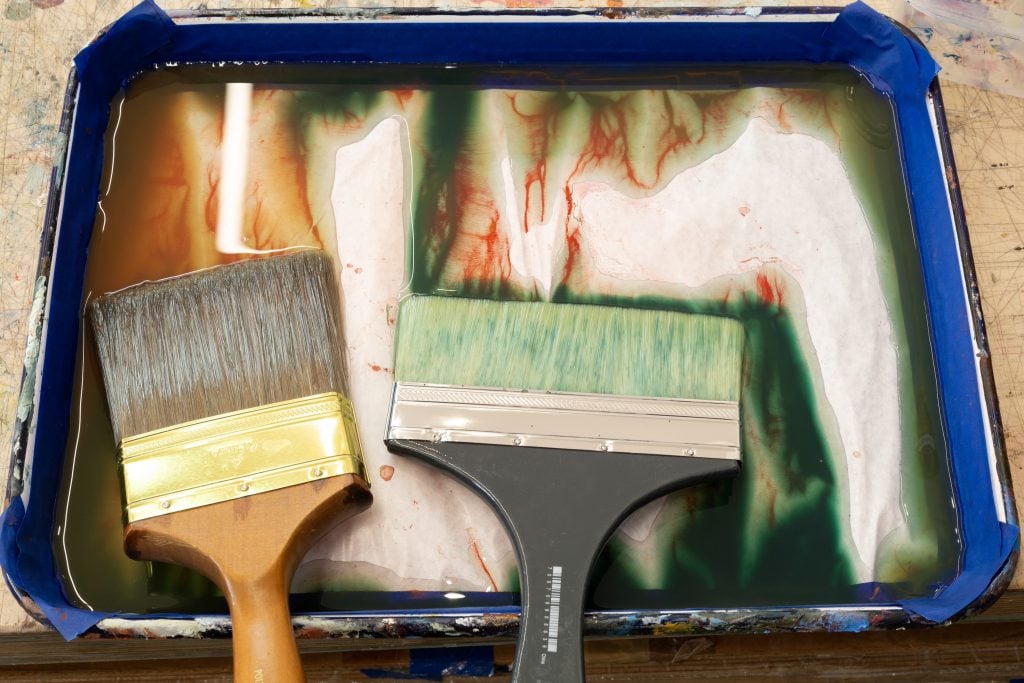
Portrait of Janaina Tschäpe in her studio, 2024. Photo: Vicente de Paulo. Courtesy of Janaina Tschäpe Studio.
A new monograph about your work is forthcoming with writing by art historian Joachim Pissarro. Did you learn anything about your work through that process?
Working with Joachim Pissarro on the monograph was a wonderful experience for me. He had so much insight and context, often making connections that I had not previously made to literature, history, and a broader artistic journey. His references to literature were particularly stimulating for me, as it’s a passion of mine.
What do you see as the influences on these new works?
Octavio Paz, one of my favorite poets, and Friedrich Schiller, whose works resonated with me during my years in Germany, have been significant influences. Alexander Von Humboldt, with his holistic view of nature—connecting mountains, plants, weather, and species— deeply inspires my work. His approach to understanding the interconnectedness of everything, combined with his background as a biologist, explorer, and researcher, mirrors my desire to carve out spaces where memories and visions intertwine with mark-making and the language of the brushstroke. I see my work as a continuation of this dialogue, connecting fragments of memory with broader ideas and emotions.
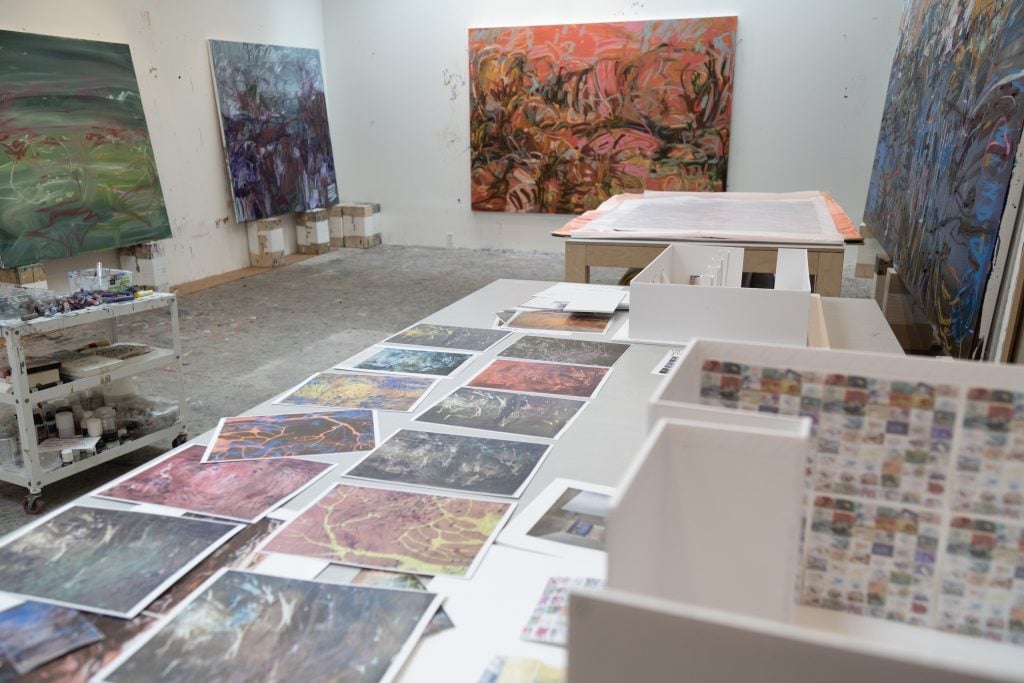
Inside Janaina Tschäpe’s Bed-Stuy studio, 2024. Courtesy of Janaina Tschäpe Studio.
What kind of atmosphere do you prefer when you work?
There is something visible about sound, when it vibrates and moves the air, it seems as if I can see how these sounds fill the space and how sound changes the space; there are chords that rise to the heights and others that descend to plumb the depths. I often get the impression when painting that I am coordinating an ensemble as if I were conducting an orchestra.
The space is also filled with materials and ongoing projects, which is part of the creative process for me. I draw inspiration from reading poetry. I have books regularly lying around the studio that I pull from for inspiration
When you feel stuck while preparing for a show, what do you do to get unstuck?
I don’t really get stuck in the traditional sense because each painting naturally leads to the next. However, if I do feel blocked on a specific piece, I simply put it aside rather than risk ruining it. Over time, I’ve learned the importance of knowing when to stop and step back. It’s a maturity that comes with years of experience, allowing me to control the process and approach each work with patience.
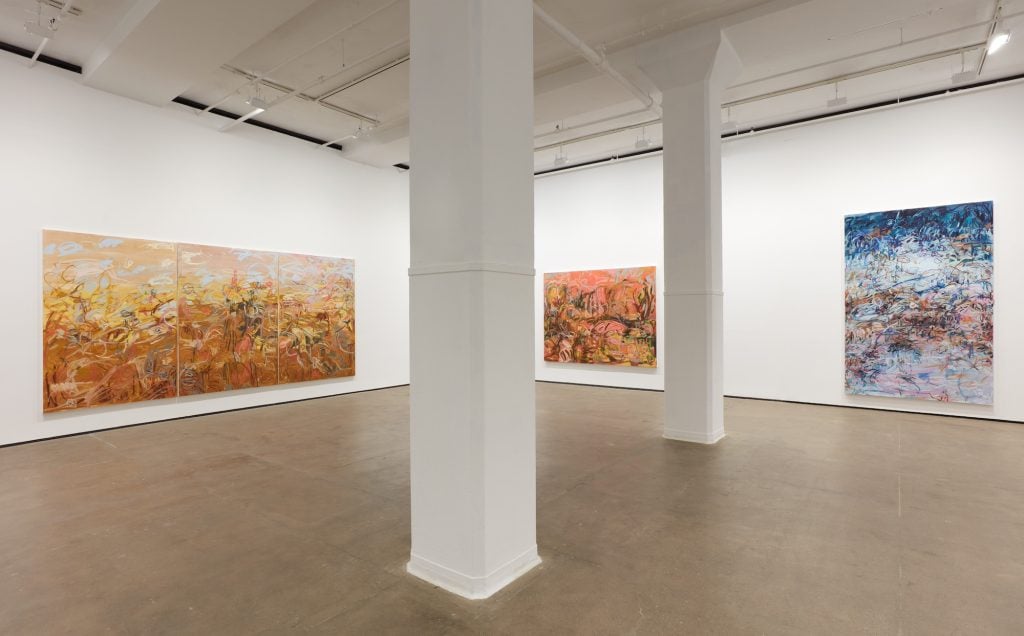
Installation view of “Janaina Tschäpe: a sky filled with clouds and the smell of blood oranges” at Sean Kelly, New York. Photography: Jason Wyche, Courtesy: Sean Kelly, New York/Los Angeles.
What tool or art supply do you enjoy working with the most, and why?
I have a lot of materials in my studio, and I get excited whenever I discover something new. Recently, I’ve returned to using pastels, which I had abandoned for years. The rich pigmentation in pastels is something you can’t find in other mediums, and it’s been thrilling to rediscover this tool. I’ve been experimenting with combining pastels with large watercolor pieces, creating new textures and effects. The studio is often covered in pastel dust, and while I try to keep the mess contained, traces of paint always seem to find their way into my living space.
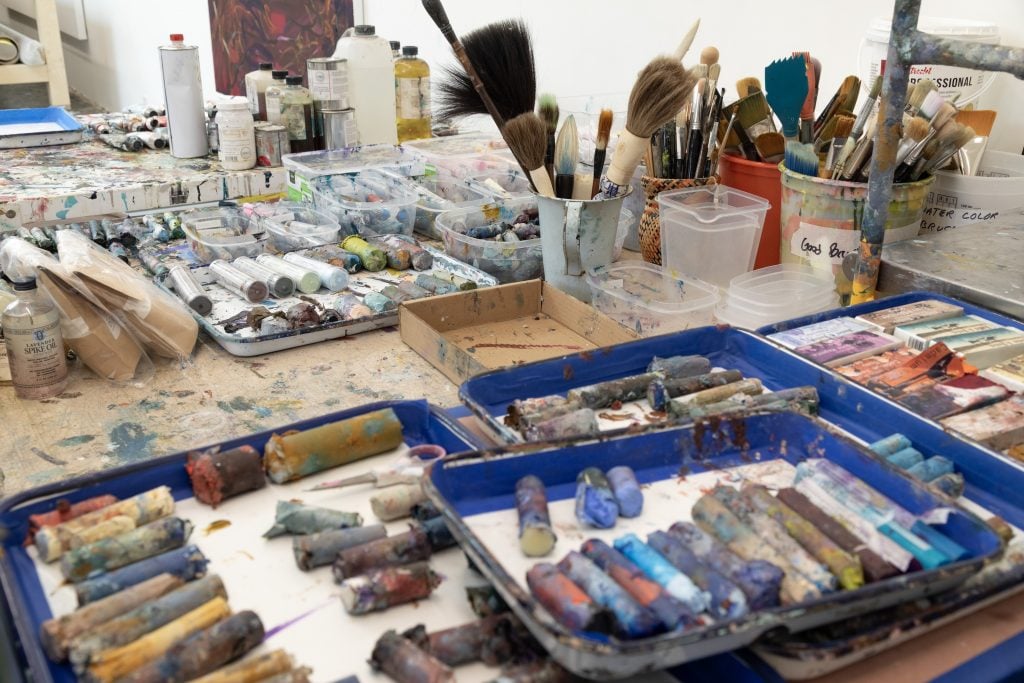
Janaina Tschäpe has recently rediscovered the pleasure of working with pastels, seen here in her studio, 2024. Courtesy of Janaina Tschäpe Studio.





